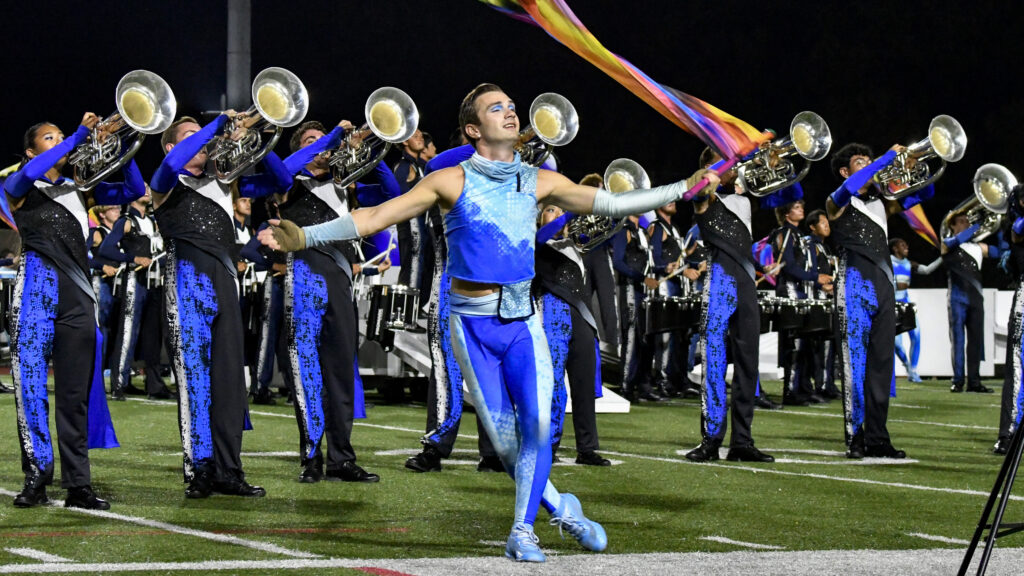Suncoast Sound’s 1988 “Symphonic Dances for the Contemporary Child” remains one of the most intriguing, audience-challenging, innovative and controversial shows to hit the field in Drum Corps International competitions.
Original compositions penned by corps arranger Robert W. Smith, with a visual program largely conceived by Karl Lowe, the show generated quite a buzz that season.
Suncoast Sound began its life in 1979, growing out of the innovative and successful Largo High School Band of Gold, which in its day was arguably the premier marching band in the south. The band, under the direction of corps founder Bob Cotter, Sr., gave birth to marching band arrangers Bob Cotter, Jr. and Jay Bocook. Bocook became a DCI Hall of Fame member after writing for Spirit of Atlanta and then becoming very well known for his work with The Cadets.
The Florida corps steadily moved up through the ranks, from 40th to 30th to 21st and finally to 13th in 1982. Suncoast Sound first made the DCI World Championship Finals in 1983, taking sixth place, and was a finalist every year through 1989, placing as high as fifth in 1986. Financial challenges made it impossible for the corps to return as a Division I competitor after 1989.

The 1988 show, which gave the corps a 10th-place finish with a score of 89.10, began with a performer dressed as a little girl discovering a ball representing a globe. Color guard members were dressed in the colors mentioned in the title of the opener, “Red and Yellow, Black and White,” representing children from around the world.
The introductory moments of brass “sighs” — said by 1988 Suncoast Sound visual staff member Ron Ellis to represent the “Nyaa Nyaa” of kids playing in the playground — and assorted brass arpeggios led into a classic Suncoast Sound brass fanfare wail of “Jesus Loves the Little Children,” reminding all of the power of the line under the direction of DCI Hall of Fame members Robert W. Smith and Frank Williams. This was followed by an upbeat rendition of the fanfare celebrating the playful innocence of children, also quoting from “London Bridge is Falling Down.”
The piece “This is the Way We…” played off the nursery song, “This is the Way We Go to School,” perhaps better known as “Here We Go Round the Mulberry Bush.” Color guard members were dressed head-to-toe in fabric as rag doll stick figures, offering a sometimes-dark view of the problems children go through.

“Wait ‘Til Your Father Gets Home” continued on the threatening level with belts cracking as the horns formed the outline of a house that was not quite a home. As various guard members took away the ball of the world from the little girl, four huge flags that seem to abstractly represent non-specific nationalities, filled the field with a visual threat of dominance on a far greater level.
During much of the show, the movements seem to blend together, so it’s difficult to make a clear delineation regarding where some of the visuals representing one movement ended and the next ones began. However, there was no doubt about where “War” began. The color guard rifles — wearing full head coverings — became quite militaristic to the drum feature as the little girl donned a helmet and took a rifle in defiant posturing.
As if the message wasn’t clear by that point, the horns and drums formed a giant mushroom cloud, a warning of the possible results of nationalistic extremism.
The color guard formed a backdrop of the Vietnam memorial wall at the beginning of “For Yesterday’s Child,” a tender ballad in tribute visually restating a powerful moment from the corps’ “Requiem” in its 1984 Vietnam-era show. The guard, now attired in solid white and also presenting a short sign language moment that reflected on the corps’ famous “The Greatest Love of All” in 1983 (and the two years previous before the corps made the Finals), took up solid fluffy white flags to change the mood to contemplation and hope.
A fanfare of bravura followed. Then the front ensemble percussion took over with a gentle theme while the horns silently poured into a company front at the front of the field and unleashed three very loud chords out of key.

As the ball of the world escaped from the hands of the little girl, it was up to the individual members of the audience to figure out for themselves the meaning of this most unexpected way to end a show.
As a production that generated much thought and discussion and even controversy, even today, individuals likely will view the various components of the show differently. My impressions are undoubtedly different than those of others. Perhaps that’s part of what was the goal of this show, and perhaps, just as easily, it’s not.
1988 Overview

Michael Boo was a member of the Cavaliers from 1975-1977. He wrote about the drum corps activity for more than 35 years while serving as a staff writer for various Drum Corps International projects. During his lifetime Boo wrote for numerous other publications including an honors-winning book on the history of figure skating. He also was an accomplished composer. Boo passed away in 2020.





